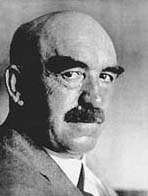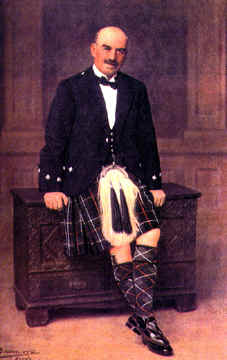 In 2005 Dr. Alister MacKenzie was inducted into the World Golf Hall of Fame in the lifetime achievement category. He became the first architect included in the hall. His induction is no mystery. Consider some of his courses: Cypress Point, Crystal Downs, Royal Melbourne, and Pasatiempo. His crowning work is Augusta National, one of his first designs in the States and a collaborative work with the great Bobby Jones.
In 2005 Dr. Alister MacKenzie was inducted into the World Golf Hall of Fame in the lifetime achievement category. He became the first architect included in the hall. His induction is no mystery. Consider some of his courses: Cypress Point, Crystal Downs, Royal Melbourne, and Pasatiempo. His crowning work is Augusta National, one of his first designs in the States and a collaborative work with the great Bobby Jones.
Wiley, the publisher that printed The Life and Work of Dr. Alister MacKenzie, said of the doctor, “He liked to wear kilts, but he wasn’t a Scotsman. He graduated from medical school, but he never made a living at it. He designed spectacular courses, but he was not a good golfer. At the height of his career he was one of the most sought after designers in the world, but he was nearly broke when he died.”
 Born in 1870 in Yorkshire, England, MacKenzie became one of the first designers who had not been a leading player in golf. His lack of prowess on the course wasn’t a handicap. His knack for understanding risk, reward, and the nuances of the game is clear to anyone who plays one of his courses.
Born in 1870 in Yorkshire, England, MacKenzie became one of the first designers who had not been a leading player in golf. His lack of prowess on the course wasn’t a handicap. His knack for understanding risk, reward, and the nuances of the game is clear to anyone who plays one of his courses.
His one-time collaboration with Bobby Jones produced what many consider the Sistine Chapel of golf, Augusta National. There is subtlety and challenge at Augusta National, a course that prevents any but the best to flourish. Donald Ross was clearly disappointed that Bobby Jones had not selected him for the design and construction of Augusta National. Jones chose MacKenzie because of their shared appreciation for St. Andrews. He had wanted to fashion an inland course that would reflect the spirit of St. Andrews and MacKenzie, author of The Spirit of St. Andrews, was the perfect man for the job.
While Jones was involved in the process, MacKenzie was given full control over the development of the course and certainly created a masterpiece to confound the greatest players. “MacKenzie and I managed to work as a completely sympathetic team. Of course, there was never any question that he was the architect and I his advisor and consultant,” said Jones in his book Golf is My Game.
I find the recent changes to Augusta National disappointing from a historical perspective. There were very few changes to the course until recently when Augusta led in the much publicized “Tiger proofing” craze. I’m reminded of what Alister MacKenzie scribbled in the margin of a book he presented to the keepers of Cypress Point, “A golf course that is altered is an indication of a faulty design.” Augusta’s recent changes don’t reflect a faulty design but a protective reaction to Tiger’s 1997 12-stroke winning masterpiece.
 On par with the courses he offered the world are his 13 ideals for golf course design. He believed there should be a short walk between a green and the next tee, there should be an emphasis upon natural beauty, not on artificial gimmicks, a course should be enjoyable for the weaker player and challenging for the stronger player, there should be an absence of searching for lost balls, therefore, an absence of heavy rough, and a player should be forced to use every club in the bag. “13 General Principles of Architecture” was included in his book Golf Architecture, written in 1920. No doubt you’ll identify some of these general rules as important ideals in modern golf course design.
On par with the courses he offered the world are his 13 ideals for golf course design. He believed there should be a short walk between a green and the next tee, there should be an emphasis upon natural beauty, not on artificial gimmicks, a course should be enjoyable for the weaker player and challenging for the stronger player, there should be an absence of searching for lost balls, therefore, an absence of heavy rough, and a player should be forced to use every club in the bag. “13 General Principles of Architecture” was included in his book Golf Architecture, written in 1920. No doubt you’ll identify some of these general rules as important ideals in modern golf course design.
MacKenzie plied his trade in an era devoid of bulldozers. When he stepped onto the future site of a golf course he was forced to unearth a course that was already there as he didn’t have the ability to move large amounts of earth. Thankfully, there are modern day architects who are adopting the same strategy in golf course design.
Another of Mackenzie’s techniques was to utilize the natural contours of the land in fashioning greens, adding undulations and tiers to blend with what nature had provided. It was a fitting and sneaky tactic employed by the man who had developed camouflage techniques for the British army in the Boer War and World War II.
MacKenzie died on January 6, 1934. He never saw Masters but generations of players and fans have enjoyed his contribution to golf history in both the substance of his work and his definition of design. If I was going to pick the greatest golf course designer of all time, MacKenzie would be right at the top of my list.
Photo Credits: © Golf Today Magazine, © Golf Web.
I have had the privilege to play two of Dr. MacKenzie’s courses – Pasatiempo in Santa Cruz, CA. and The Valley Club of Montecito in Santa Barbara, CA. Both are masterpieces and must not be missed if given the opportunity to play. Given he has designed most of the world’s most famous and best courses, today’s architects should follow his 13 rules.
This brilliant designer made one other gem. Its Stanley park golf course in Blackpool. Its challenging fast greens small “punchbowl” type and its a municipal course!
Play a mini augusta without the weather or golden sand but experience the challenge of hitting postage stamp sized greens.
One of Alister MacKenzie’s great achievements was Green Hills Country Club in Millbrae, California. It now has been in existence for over 80 years, and continues to get better and better.
It challenges the best golfer, yet makes it an enjoyable round for the beginner – quite the feat in design!
The greens and fast and true. The fairways are narrow, but plush. The traps are indeed “MacKenzie” traps.
It is truly a joy to play.
Dear Sir:
Approximately a year ago, a young golf course architect to be stopped where we were planning a new golf course. during his visit the term Bunkers came up. He sugggested that he had read that the term came from some sort of use of military grounds where amunition bunkers came into play and attributed the concept to Dr. MacKenzie.
We have since attempted to locate the reference but have not been successful. Can you help? What is the origion of the term “Bunker” to denote an obstcale on a golf course?
Dick Carr
If you’re interested in MacKenzie, you have to play Pasatiempo in Santa Cruz. Pasatiempo was MacKenzie’s home course, he lived along the 6th fairway until he passed away in the mid-30s. It’s perennially ranked in the Top 100, and it’s semi-private, which means that it does permit some public play. Though MacKenzie designed Cypress Point, Augusta, Royal Melbourne and Lahinch, he described Pasatiempo’s back nine as “perhaps the finest in existance” and Hole #16 as the best par 4 he had ever seen. Lots of great views of Monterrey Bay too. Don’t miss it.
If you play a MacKenzie course, do yourself a huge favor and leave your modern golf gear at home. Play the course as it was intented so you can appreciate the genius that was MacKenzie. Use real woods and blades regardless of your skill level… I promise it will be the best experience of your life!
Hi,
i enjoyed this site very much indeed, he also re-designed Pollock Golf Course in Glasgow in 1929 a wonderful Parkland course set in the natural surroundings of Pollock Country Park. Glasgow`s most elite Golf Club and a favorite of past years for Sir Sean Connery.
Gordon Howe Glasgow